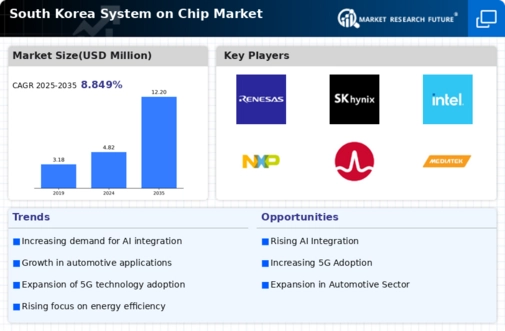Emergence of IoT Applications
The emergence of Internet of Things (IoT) applications in South Korea serves as a critical driver for the system on-chip market. As industries increasingly adopt IoT solutions for automation and data collection, the demand for specialized chips that can handle diverse applications rises. In 2025, the IoT market in South Korea is anticipated to expand by 15%, creating a substantial opportunity for system on-chip manufacturers. These chips are essential for enabling connectivity and processing capabilities in various devices, from smart appliances to industrial sensors. The growing emphasis on smart cities and connected infrastructure further amplifies the need for efficient system on-chip solutions. Consequently, companies are likely to focus on developing chips that not only meet performance requirements but also adhere to energy efficiency standards, thereby enhancing their market competitiveness.
Surge in Consumer Electronics Demand
The system on-chip market in South Korea experiences a notable surge in demand driven by the increasing consumption of consumer electronics. With the proliferation of smartphones, tablets, and smart home devices, the need for efficient and compact chip solutions becomes paramount. In 2025, the consumer electronics sector is projected to grow by approximately 8%, further propelling the system on-chip market. This growth is indicative of a broader trend where manufacturers seek to integrate advanced functionalities into smaller form factors, thereby enhancing user experience. As a result, companies are investing heavily in research and development to create innovative system on-chip solutions that cater to the evolving needs of consumers. The competitive landscape is intensifying, with local firms striving to capture market share by offering cutting-edge technology and improved performance in their products.
Rising Focus on Automotive Electronics
The rising focus on automotive electronics in South Korea significantly influences the system on-chip market. With the automotive industry increasingly integrating advanced technologies such as autonomous driving and connected vehicles, the demand for high-performance chips is on the rise. In 2025, the automotive electronics market is projected to grow by 12%, creating a substantial opportunity for system on-chip manufacturers. These chips are essential for processing data from various sensors and ensuring seamless communication between vehicle systems. As automakers prioritize safety and efficiency, the need for reliable and efficient system on-chip solutions becomes critical. Consequently, manufacturers are likely to invest in developing specialized chips tailored to meet the unique requirements of the automotive sector, thereby driving innovation and growth within the system on-chip market.
Investment in Semiconductor Manufacturing
Investment in semiconductor manufacturing in South Korea plays a pivotal role in shaping the system on-chip market. The government and private sector are channeling substantial resources into expanding production capabilities and enhancing technological expertise. In 2025, the semiconductor industry is projected to contribute approximately $100 billion to the national economy, underscoring its significance. This influx of capital is likely to facilitate the development of advanced manufacturing processes, enabling the production of more sophisticated system on-chip solutions. As local firms strive to maintain a competitive edge, they are expected to prioritize innovation and efficiency in their manufacturing operations. This trend not only supports the growth of the system on-chip market but also positions South Korea as a key player in the global semiconductor landscape.
Advancements in Telecommunications Infrastructure
The ongoing advancements in telecommunications infrastructure in South Korea significantly impact the system on-chip market. The rollout of 5G technology necessitates the development of high-performance chips capable of supporting faster data transmission and improved connectivity. As of November 2025, the South Korean government has invested over $2 billion in enhancing its telecommunications framework, which is expected to bolster the demand for system on-chip solutions. This investment not only facilitates the deployment of 5G networks but also encourages innovation in chip design, enabling manufacturers to create more efficient and powerful products. The integration of system on-chip technology into telecommunications devices is likely to enhance overall network performance, thereby attracting further investments and fostering growth within the market.




















Leave a Comment